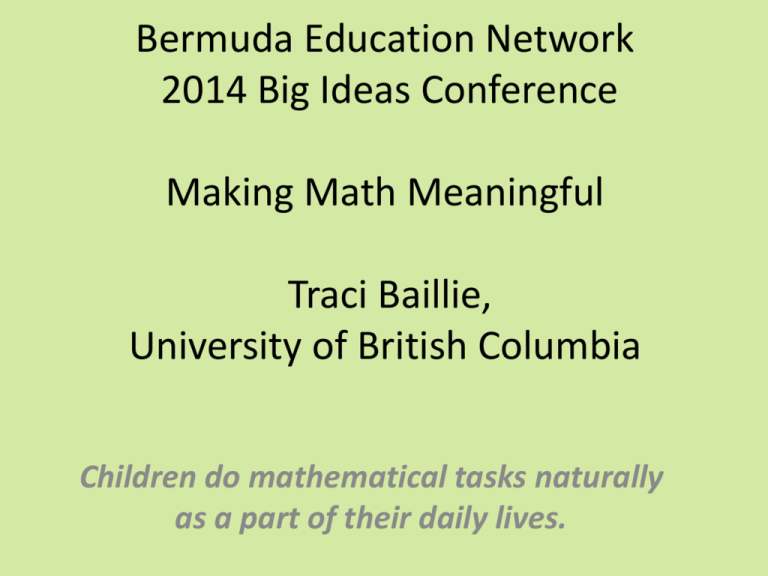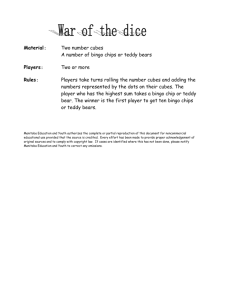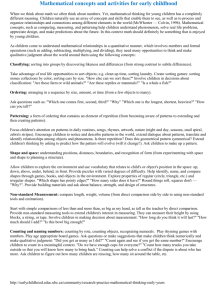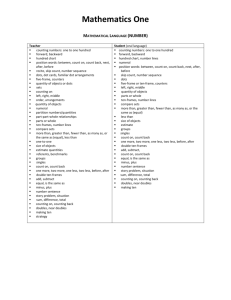to presentation - Bermuda Education Network
advertisement

Bermuda Education Network 2014 Big Ideas Conference Making Math Meaningful Traci Baillie, University of British Columbia Children do mathematical tasks naturally as a part of their daily lives. Making Math valuable to everyone every day by ensuring it is: Meaningful: Arrange real world contexts, provide interesting materials & manipulatives, active movement for all, all day long Challenging: Individualize and Extending learning, Promote thinking and deepen it Collaborative: Allow time for focused engagement, reflection, group work and change Meaningful Arrange real world contexts: The best lessons are lessons that have a clear purpose, concise goal, streamlined teaching and maintain academic flow. Go Outside- playground, beach, look at the buildings, cars, flowers, trees, boats. Listen to kids’ daily life activities and incorporate it into day to day activities ( calendar, graphing, etc.). Use Bermuda life activities- i.e. Ag show, Bermuda Day, Sports events Provide interesting materials & manipulatives,: Collections of “found” items such as rocks, bark, shells, leaves, assorted vehicles (die cast, plastic, wooden, varied sizes), dinosaur/animal collections, manipulatives such as seeds, dried beans, etc. Active movement for all: Brain research shows max time = 1 yr./ 1min. @ max of 15. Get students moving as often as possible. Challenging: Individualize and Extending learning, Promote thinking and deepen it Collaborative: Allow time for focused engagement, group work, &reflection DO, TALK, RECORD // Engage & Activate, Work on it, Reflect & Connect A) Do/model an activity, share the language and model A) Work on it in groups – focused engagement A) Reflect: Talk about the ‘hows’ and review with each other What did you notice?, How did you figure that out? Why do you think that? How does it help you?, Why does that make sense to you? D) Connect// Record - journals, worksheet, games, verbal (You are saying that… I think you have …It seems to me that you can… I learned that this is similar to…. Math Journals When children write in math class, they have to revisit their thinking and reflect on their ideas and it gives teachers a way to assess how their students are thinking and what they understand. Teach students the power of “Is your answer logical?” Journals are: • Focused on the flow of the curriculum • Way of representing mathematical thinking and problem-solving in words, pictures and/or numbers. • Can cover: patterning, counting, grouping, addition, subtraction, graphing, shapes, symmetry, graphs, multiplication, etc. • To be used after groups, math centers/workshop/tubs Ideas for Math Journals F-P2 Design your own or purchase for younger students. • I can show 2 shells plus 4 shells. (addition) • I can draw 10-4= 6 and 10-6=4 (subtraction) • I can make a pattern with dots. (patterning) • Here is a cake divided for 4 people. (division) • I can show 2 groups of 6. ( multiplication) • I can draw shapes with 4 sides ( shapes) Ideas for Math Journals P3-P5 Have students ask a question. ( flipping the classroom approach) Use Prompts to help them write: It means… OR I solve 99 + 5 by….. OR I can show….. Use starter problems: There are __ boys and ____ girls in the class . Together, there are ___. (show using a number line) HOW? WHEN? 1. Transitions 2. Teacher initiated large group lessons 3. Teacher directed conversations and projects 4. Small group work (i.e. Surprise box) 5. Math centers (teacher directed /student directed) 6. Morning circle/carpet time (Calendar: patterns, counting, etc.; Money, problem of the day, saving for a special day); Days of the week; 100 day activities; Patterns and Collections- connect to Bermuda 7. Child initiated play centers (hands on materials, games, exploratory play, object play, puzzles, buckets of manipulatives (buttons, keys, shells…), geoboards, tangrams & patterned design sheets, unifix cubes, pattern blocks, attribute blocks, Cuisenaire rods, stamps/objects for patterns, pocket charts, laminated placemats with add/subtract, Venn diagrams, 3 size circles, etc., measuring devices such as scales, thermometers, meter stick, rulers, etc., wooden numerals, and number lines) 8. Connections to literature (stories, games, etc.) 9. Question of the day/Problem of the week 10 Routine Activities 1. Using a calendar, count the number of days in school ( 2s,3s..) 2. Follow the color pattern on the weather chart. 3. Incorporate movement in math (use body parts to show a given number, jump, hop, etc. for special number of the day 4. Use money for each day ( each day is a penny and 10 pennies make a dime, etc.) 5. Count days and use a 100 day chart and count by 5s for each week. 6. Surprise Box Everyday are put items in a “surprise box.” Have one student shake it. Children guess what they think is inside. After that, the box is opened up to see what is inside. Items are counted and sorted. If possible patterns with the objects can be made or they can be used to measure things For example, students have 10 unfix cubes that are connected and have them find objects in the class that are smaller or shorter, taller or bigger, and the same size as the 10 unfix cubes. . 7. Number of the Day As part of a routine, the special helper rolls a die . The class counts the number of dots that come up on the die. The special helper chooses one or more actions for the class to do. For example, if a 5 is rolled, and special helper chooses clap, jump, and wiggle, the students do each action 5 times while counting. All day long the number is used for as many activities as possible. 8. Question of the Day: The materials needed are a magnetic board/white board or a pocket chart and Student individual photos with names on magnets or laminated cards. As the children enter they will ‘read ‘or independently the graph question and place their photo/name magnet on graph, according to their preference or answer. • “ I came to school by ____ car _____ foot, “ I have 1, 2, 3 brothers/sisters; etc. 9. Problem of the Week 10. Everyday Patterns 1. Identify and discuss patterns on children’s clothes, hair color, shoes, etc. Create a people pattern for children to see and experience. Students get into a large circle and start with simple patterns such as sitting and standing. Children guess the pattern and then chant the pattern as they follow it one by one, either sitting or standing. In this way, all the children are involved in the extension of the pattern. Patterns become more complex as children get used to the concept. 2. Identify AB and ABC patterns, etc. with objects and shapes Give children objects ( Materials: Color geometric blocks, beads, color tiles, small toys, snap cubes, bingo chips, geoboards, foam blocks, cultured wooden blocks, straws, and buttons , materials are collected from outside, and include, leaves, rocks, sticks) Teacher starts a Lego structure with patterns build into it. This is to show students those patterns are found everywhere. Patterns are incorporated into various Lego structures. 3. Students do a clapping pattern and others repeat. Incorporate physical 10. Everyday Patterns 2. Identify AB and ABC patterns, etc. with objects and shapes Give children objects ( Materials: Color geometric blocks, beads, color tiles, small toys, snap cubes, bingo chips, geoboards, foam blocks, cultured wooden blocks, straws, and buttons , materials are collected from outside, and include, leaves, rocks, sticks) Teacher starts a Lego structure with patterns build into it. This is to show students those patterns are found everywhere. Patterns are incorporated into various Lego structures. 3. Students do a clapping pattern and others repeat. Incorporate physical movement into it , too. Thoughtful Planning of Learning Centers Why Centers? Centers offer students an opportunity to explore, discover and develop their skills in all curricular areas through carefully planned teacher-directed and student-directed activities. Students have an element of choice and the opportunity to represent their learning in a variety of ways. Activities are modeled or explicitly taught. Student-directed/child-initiated play: children select and initiate their own activities = feeling of control ↑ engagement a variety of learning areas (dramatic /creative play, science, numeracy, literacy +) interact with others, recognize and solve problems: develop language, thinking, and motor skills. Teacher-directed/teacher initiated play: facilitated by the teacher → large group approaches that introduce new materials, ideas, and activities which children can later explore on their own. Systematic and sequenced, it may examine specific skills and concepts in areas such as literacy or mathematics. Thoughtful Planning of Learning Centers What to think about when setting up centers: They need to be well organized and stocked with the required supplies and materials for specific activities (which can be changed over the course of the year) Accessible to the students to foster independent, student-directed learning experiences. Used in multifaceted ways - providing a variety of choice on a daily basis (literacy, math, science, creative play) but can also be customized for one particular theme, for example six different math centers based on one mathematical concept (like patterning) while offering differentiated approaches to student engagement. Incorporate literacy activities into every center → introduces authentic purposes for reading, writing and numeracy. Resources Elementary Teachers’ Federation of Ontario (ETFO) Video – Kindergarten Makeover http://www.etfo.ca/Multimedia/Webcasts/Pages/KindergartenMakeover.aspx Full Day Kindergarten Program Guide http://www.bced.gov.bc.ca/early_learning/fdk. Surrey District - Kindergarten Handbook – Learning Centers http://www.bcpta.ca/UserFiles/File/Centres1b.pdf A few fun activities to try • • • • • License plates Teddy Bear/Chicks Counting Who has.. Game Dice Games/Activities Sorting and Classifying There are a few activities at each table. You have 5 min to try 1 - 2 and discuss it with your group before moving on. License Plates or Running Numbers Ask all students to bring in the number on a license plate their bike, car or the bus OR all bring in a running bib. Have them copy them on large papers and arrange students in groups of 4. For competition, the first group who finishes wins. Game 1: Each member adds up the digits in the their own license plate ( may need manipulative for younger students) and for a challenge- add it all together. They may help each other. Game 2: Try making the largest number from a license plate by rearranging the order of the numbers. For a challenge, have the students put the group members’ licenses in order. Game 3: Have children write out all numbers in the license plate which are are odd , then even and then which ones are prime. Game 4: Skip count with the first of last number. For instance, if the last number in a license plate is 3, see how far the group can count by 3s. Game 5: Multiply the numbers in the license plate ( older students). Dice/Number games Materials: dice and a strip of paper with the numbers 1-12 Activity: Younger students 1.Each student/group has a strip of paper with the numbers 1-12 or 1-100 2. Students roll a die and cover over the number that they roll with a counter. First person to cover up their strip first wins. Variations: • Play with a strip 7-12 and 2 dice. • Play co-operatively and try to cover up the strip together • Multiplication Scramble ( as played at station) Teddy Bear, Teddy Bear & Number Chicks Patterns , Relations and Counting Game Materials: One die, Printable sheet,& counters Activity 1 Teddy Bear: Give each player a stack of colored counters. Youngest child rolls first. He places his counter on the teddy with the corresponding number, and then passes the die to the next player. If there is already a counter on the appropriate teddy, you miss your turn. When all the teddies are covered, count up the counters. Whoever has placed the most counters is the winner. Activity 2: Counting Chicks: This game is played the same way but with the numbers. Extension: 1. Use 2 dice and add numbers 7-12 to the Counting Chicks 2. Try this activity: http://www.themeasuredmom.com/free-preschool-math-gamemonster-dice-match/ 3. Try this activity: http://preschoolalphabet.blogspot.com/2011/06/dice-game-numbers.html I Have / Who Has Game 1. Make a set of index cards with two sections (like dominoes), and write one number or representation of a number on one side and another number in another color on the other side OR use a set made already ( as I have done here) 2. Hand out the cards to each student. If there are extras, please take 2 each. 3. One person begins by reading their car, “ I have… who has” while others listen for the answer that is on their card. The person with the correct answer reads his/her card. 4. The game continues until the game comes back to the starting card. The student who has started has to say ‘stop’ to end. 5. This can be competitive by timing the round and playing again to beat the current time. Here is a website with cards you can download! http://math-mania.pcsstn.com/resources/i-have-who-hasgame-cards Race to 100 Materials: Groups of 2 students, 100 chart, 1 die, and 2 different coloured crayons The first student roles the die and colours in the number of squares that match the number rolled on the die (beginning at square one). The next child rolls and colours in the corresponding number of squares. This continues until they reach 100. Card Games: Partner War Materials: 1 card deck Activity: • Remove the face cards out of your deck of cards, so that only the number cards are left. Place students in pairs. The two students divide the card deck in half. The children sit across from each other and flip over two of their cards. At that point one child adds his/her two cards by saying it out loud (2(one of the card numbers) +3(the other card number)=5). Followed by such, the other child does the same thing. The child in the pair who has a greater number says “I win” and takes both pairs (places into a separate pile). • Continue until A)The children continue to play the game until there are no cards left. At this point each child counts his/her cards. The child with the most cards wins! B) The children play only 5 rounds while each recording each round on a score card for both players . At the end of 5 rounds, the scores are added up to determine the overall winner. Variations can be done to make it a bit more advanced by adding an additional 3rd card to each game ground or by using multiplication. You can also play that two cards are played at once, and added together. The highest sum wins the trick. http://www.pagat.com/invented/war_vars.html Using a Rule to Sort 3-D Objects Class Activity: Choose 6 students to come to the front of the group and sort them into two groups based on an attribute of your choosing (Such as hair color, eye glasses, etc.) • Tell students “I’ve sorted this group of students into two groups and I want you to think about my rule for sorting” • Have students guess rule for sorting. After some thinking time, ask, “What’s my rule for sorting?” and “How do you know?” • Groups: Students work in groups to think of ways to sort. The group presents their sorting to the rest of the class, without revealing their rule. The rest of the class guesses the rule. OUR ACTIVITY TODAY-. Work in partners and use a rule to sort each baggie of items. Share your ideas with the group. • Reflect and connect: Ask students what else they can sort into categories. When is it easy? What will make it more difficult? Sorting Rules Examine the items in each brown bag (4) to determine how they were classified. Can you guess the sorting rule for each collection? 1. 2. 3. 4. Sorting Rules Examine the items in each brown bag (4) to determine how they were classified. Can you guess the sorting rule for each collection? 1. 2. 3. 4. Sorting Rules Examine the items in each brown bag (4) to determine how they were classified. Can you guess the sorting rule for each collection? 1. 2. 3. 4. Sorting Rules Examine the items in each brown bag (4) to determine how they were classified. Can you guess the sorting rule for each collection? 1. 2. 3. 4. Giant Jumping Number Line Objective: The player who lands on the last number line, wins Number of players: 2-5 players where one player can roll the dice/die Materials: 2 giant dice/ a giant die, giant number line, tape/something to hold down the number line on the floor Activity:: Players line up, single file, on “zero” (behind 1). Each member of the class takes turn rolling the giant dice/die on the giant number line. The player hops to the number that corresponds with the number shown on the dice/die. Variations:. Have two number lines—1 one with numerals and dots, one with only numerals. Children who can read the numerals can use the number line with only the numerals on it. The visuals, the dots, help children make a connection to what the number represents (the value). Those who cannot read the numeral, may find the number line with the visual helpful. Players can start from the top or the bottom of the number line. Children can learn to count forwards and backwards, or even skip count. As a challenge, players can extend the number line to twenty. Children can take turns rolling the dice/dye (2-4 players) or designate one Erase It Game • Activity: Teacher ( and students) draw several different arrangements of dots from 1 to 10 (or numbers, odd numbers, even numbers, a mixture, whatever the skill) scattered around the board. • Students have a turn to come up to the board, point to an arrangement of dots that they know and identify it by naming its value. • If it is correct, then they get to erase it. If they identify the arrangement of dots incorrectly, the teacher tells all of the students the correct answer so everyone will know the number for that arrangement of dots. So for the person who is next, if they have been paying attention, they will know the answer. Students only erase if they get the answer correct. The students keep taking turns answering until all the arrangements of dots are erased. Incorporate ‘fun’ materials Division: Raisins, chocolate chips, Smarties, Buttons, etc. Groups of children estimate and then figure out how many raisins or smarties each of them would get if they shared a snack-size box, small bag, etc.. Sheets included in your package. Here is a good link to several activities: http://www.education.nt.gov.au/__data/assets/pdf_file/0016/52 90/maths_with_smarties.pdf Coin Rescue • Materials: Small container, sand or rice, beads of small objects, tongs • Directions: Cover the bottom of a small container with sand. Mix in small objects, coins, etc. Have students (one at a time) use tongs to rescue the items from the sand/rice. • Students them count them, tally them, and calculate the total. • Give them a price list from the local store and see if they have enough money to buy anything. Reflection Questions For Students It is essential that children have opportunties to reflect, talk and write about what they learned. You can use these to start reflection: What did you notice? • How did you figure that out? • Why do you think that? How does it help you?, Why does that make sense to you? Websites • • • • • • • • • • • • • • • • • • • • http://web.sd71.bc.ca/math/index.php?page=favourite-math-websites http://mindfull.wordpress.com http://www.awesomelibrary.org/Classroom/Mathematics/Element ary_School_Math/Kindergarten.html http://www.nvsd44.bc.ca/Math44/math44.html http://www.theclassroomkit.com/index.html http://kinderwebgames.com www.hubbardscupboard.org/math.html Mathletics.ca & Rainforestmaths.com http://www.thevirtualvine.com/math.html http://www.bbc.co.uk/schools/games/ www.stuartjmurphy.com/ http://www.pbs.org/teachers/classroom/k-2/math/resources/ http://illuminations.nctm.org/ www.beam.co.uk/ www.kidscount1234.com www.portageandmainpress.com http://www.crickweb.co.uk/ks1numeracy.html http://nlvm.usu.edu http://www.coolmath.com http://www.cut-the-knot.org




